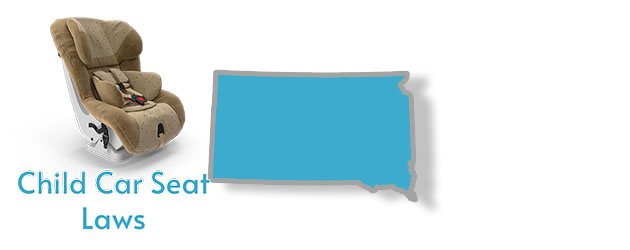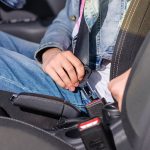A Summary of Child Car Seat Laws in South Dakota

What Are the Height and Weight Requirements for Car Seats in South Dakota?

South Dakota has some of the most lenient car seat laws in the country. Simply put, it states that children younger than 5 years and those under 50 pounds should be secured with an approved child restraint system. Best practices are that:
Children should ride on rear-facing seats until they are at least 2 years old.
Children can transition to forward-facing seats with a harness once they outgrow the rear-facing weight and height limits.
Children can ride on booster seats once they exceed the forward-facing weight and height limits.
Children younger than 13 years should ride in the middle of the back seat.
More information on best practices outlined here.
What Are the Rear Facing Car Seat Laws in South Dakota?

Rear-facing Car Seat Laws in South Dakota
South Dakota law does not cover specific requirements for rear-facing seats, the only stipulation being that children under the age of 5 be in an appropriate restraint.
According to the AAP (American Academy of Pediatrics), children should ride on rear-facing seats until they are at least 2 years old or until they exceed the manufacturer’s weight and height limits. Typically, infants usually start riding on infant-only seats once they are out of the hospital. These types of seats have lower weight limits (30-35 pounds), so most children normally outgrow them before their first birthday and then switch to convertible seats. Children can reach age 4 while still in convertible seats due to the seat’s higher weight limits (up to 40 pounds), so don’t be in a rush to transition your baby as the main goal is to stay in the rear-facing position for as long as possible. This position is considered the safest because the back of the seat absorbs most of the crash forces, thus protecting the child’s vital and fragile body parts (head, neck, and spine). Rear-facing seats should be installed in the back seat and away from an active airbag.
What Are the Forward Facing Car Seat Laws in South Dakota?

Children can transition to forward-facing seats with a harness once they outgrow the rear-facing weight and height limits set by the manufacturer. Typically, this happens when the child is between 2-4 years. Those using convertible seats can convert them to forward-facing seats by turning them to face forward once the child has met the relevant requirements. Other types of seats in this category are combination seats (doubles as a booster seat) and 3-in-1 seats. The harness straps should be used to secure the child, and they should be snug over the stronger parts of the body (shoulders and hips). This is crucial because, in the event of a crash, the straps help in directing the impact forces away from the delicate body parts and spreads them over the stronger parts. Seats of this type can support up to 65 pounds so children can remain in the forward-facing position until age 7.
What Are the Booster Seat Laws in South Dakota?

Children can ride on booster seats once they exceed the forward-facing weight and height limits. Although South Dakota law allows children to graduate to safety belts once they are 5 years old or weigh 40 lbs., it is a good practice for children to keep using booster seats until they exceed the manufacturer’s weight and height requirements or until they are big enough to fit in seat belts.
Booster seats are used to raise children so that they can fit in seat belts. They are designed to guide the lap-shoulder belts to snugly fit across the child’s upper thighs and chest area. High back and backless are the most common types of booster types. High-back is designed to support a child’s head and neck in case a headrest is not available, while a backless is used when the headrests can adequately support the child.
Children can remain in booster seats until age 8-12 due to the seats’ higher weight limits (up to 80 pounds). However, the decision to stop using booster seats and graduate to safety belts should be made based on height rather than weight and age. This is because safety belts are designed to fit anyone 4’9” or taller, so children shorter than this height may not fit. A seatbelt ready child should also be able to sit with his or her back straight against the back of the seat with knees bent at the edge of the seat and with feet touching the floor.
When Can a Child Sit in the Front Seat in South Dakota?

There is no law preventing a child from sitting in the front seat once they’ve reached the age of 5. However, the South Dakota Department of Social Services recommends children younger than 13 years should ride in the middle of the back seat because it is the safest. They also insist that rear-facing seats should never be installed in front of a passenger-side airbag.
Is it Illegal to Leave a Child in a Car Unattended in South Dakota
The law does not cover situations where children are left unattended inside vehicles. However, as a parent or guardian, you should protect your child at all times and avoid leaving them unsupervised.
Is it Illegal to Smoke With a Child in a Vehicle in South Dakota?
South Dakota does not have any laws regarding smoking in a car with child passengers. We do not recommend smoking with a child in your vehicle.
Are Car Seats Required in Taxis in South Dakota?
What is the Law on Replacing Car Seats in South Dakota?
There is no law regarding the replacement of car seats. However, safety experts recommend replacing car seats after a major or moderate car crash. Seats also have expiry dates, so remember to replace yours once it expires. The South Dakota Department of Social Services says it is not a good idea to use second-hand seats. If you must use an older seat, make sure you know the seat’s history. Don’t use it if it has been involved in a crash, has a recall, is damaged, has expired, lacks the manuals, or if it is missing some parts.
More South Dakota Laws
